Inspired by folklore and tradition, colorful ceramics are the trademark of the Southern Italian town of Seminara. I recently had the opportunity to visit one of Seminara’s five remaining workshops and to meet with Enzo Ferraro, a Calabrian ceramicist with over a century of family history devoted to the craft.
A BRIEF HISTORY OF SEMINARA, CALABRIA
Seminara is located at the tip of the Italian boot about 30 kilometers (19 miles) north of Reggio Calabria between Palmi and Bagnara Calabra. Its noteworthy political past includes turn-of-the-15th-century battles associated with the Italian Wars and a 1535 visit by the Holy Roman Emperor Charles V, who entered Seminara in a triumphal cortege to celebrate his victory over the Ottomans in Tunis.
Historically, the town has also had a reputation for its fine olive oil and silk. By the end of the 16th century Seminara had a population of over 7,000, two and a half times that of today.

Barlaam of Seminara
Its two most distinguished citizens reflect southern Calabria’s Greek heritage, which endured long past the periods of Greater Greece and the Early Middle Ages when Orthodox Churches were established throughout the territory. Barlaam of Seminara (1290-1348) was an influential Byzantine-Greek clergyman and philosopher, and Leonzio Pilato (died 1364) was the first to translate Homer’s Iliad and Odyssey into Latin. His translations were used by the likes of Petrarca and Boccaccio.
Hand in hand with this florid intellectual life, Seminara has also embraced a healthy folkloristic tradition. Examples include the Giganti, dancing puppets of giant proportions that represent the union of the indigenous and Moorish peoples, and vivid local pottery steeped in popular lore.
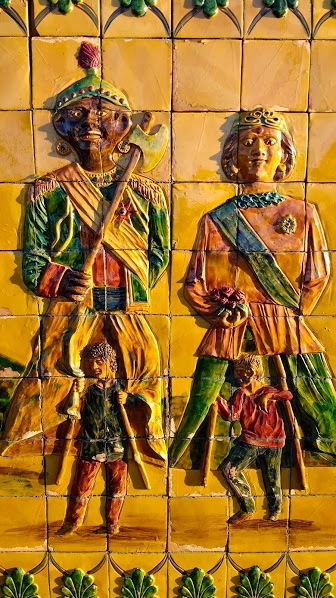
I Giganti, the Giants, tile mural by Giuseppe and Enzo Ferraro along the road in Palmi, Calabria
SEMINARA CERAMICS
Seminara has a long history of terracotta production, no doubt owing to the area’s abundance of red and white clay. Decorative pieces are finished with vibrant colors derived from natural sources. Traditionally, green, yellow and blue predominate. Characterized by original forms, bizarre faces and extremely lively colors, Seminara ceramics are imaginative, folkloristic creations full of story, hidden meaning and even magical powers.
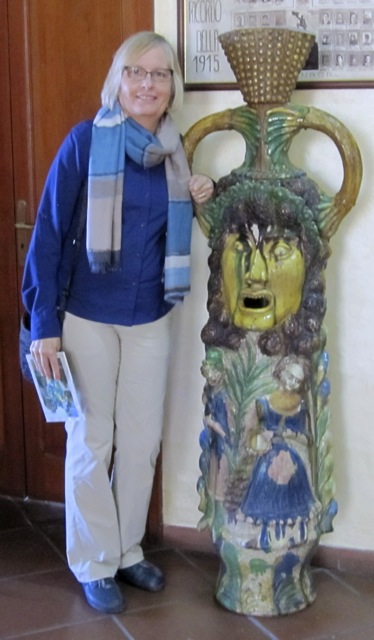
The author at the Seminara Town Hall
In the past, artisans also produced objects for everyday use, including plates, cups and various containers, as well as building materials, such as roof tiles, bricks and chimneystacks. For example, town records indicate that in 1746 there were 23 workshops in Seminara making pignatte or terracotta cooking pots.
The pottery was fired in large ovens similar to a well of two levels, with the lower containing the burning chamber, which was fueled by chestnut and olive wood as well as the pulpy residue from olive crushing, and the upper, the area in which the clay was fired. Today, most of the firing is done in modern ovens with attention to international regulations, in particular with regard to the surfaces intended for food consumption.
The forms, however, hearken back to earlier times, and according to oral history, Pablo Picasso, upon seeing the work of a ceramicist from Seminara at an exhibition in Ventimiglia, Italy remarked, “These pieces have been conceived by hands of gold that express a past that no longer exists, but thanks to these ceramics will continue to live on.” Seminara ceramics can be found in museums in the Vatican, Florence, Toronto and at the Casa della Cultura in neighboring Palmi.
ENZO FERRARO, CERAMICIST
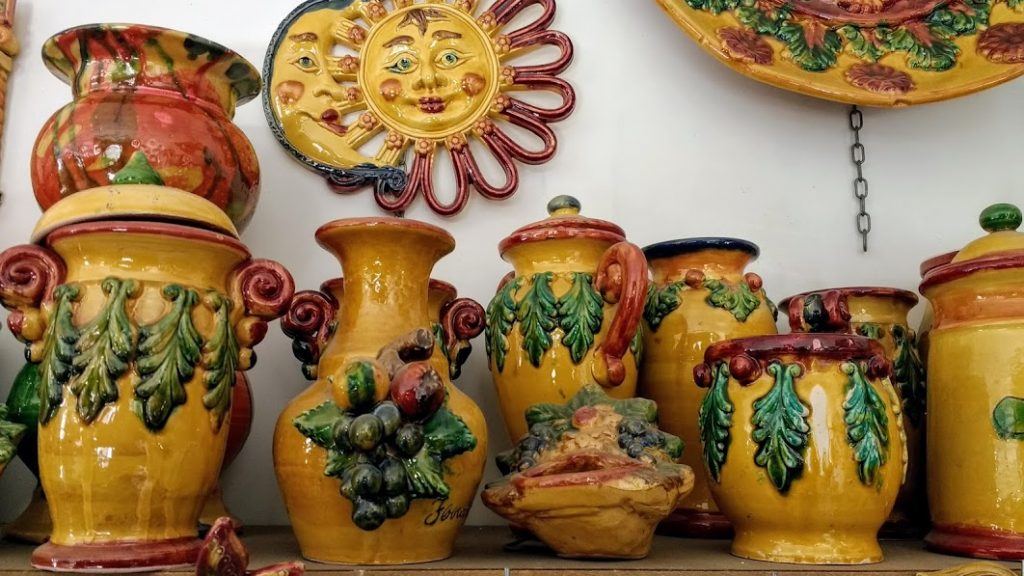
Enzo Ferraro, Ceramic Pieces in Seminara, Calabria
To get a firsthand look at Seminara’s contemporary pottery, I visited the workshop of master ceramicist Enzo Ferraro. Shiny bright colors jumped out to greet me as I entered the store. Rows of pitchers, candelabras, decorative containers and other highly ornamental objects lined the shelves and walls.
Enzo Ferraro appeared amidst the rainbow of objects with a warm smile and an outstretched hand, but politely thought better of shaking mine as he had been hard at work. So I can say I rubbed elbows with Enzo Ferraro. Friendly and curious, he talked about local traditions, specific objects in the shop and his enjoyable visit to New York and New Jersey, where he has relatives who live near the George Washington Bridge. I grew up in NJ so it was as if he had visited my hometown, too.
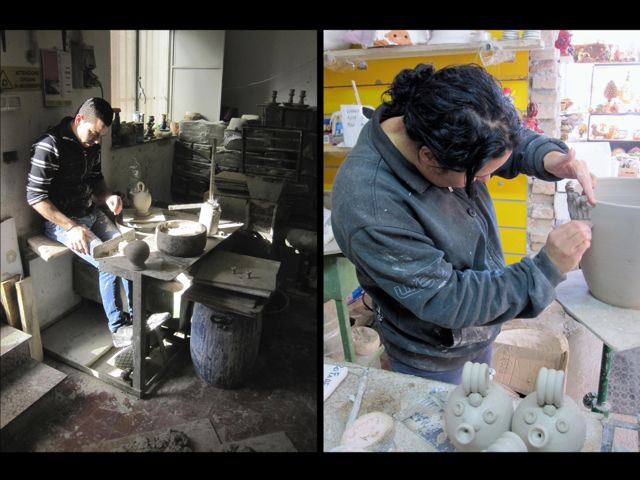
An Apprentice and Assistant at work in Enzo Ferraro’s Workshop in Seminara, Calabria
The back of the shop opened up to a work area, where his assistant and two young apprentices were hand-shaping clay embellishments and attaching them to larger forms. The basement was similar to the shop, with rows and rows of objects, except they were not yet baked, but drying in a gray monochrome. Nowadays, Enzo uses clay from Tuscany as Seminara’s repeated earthquakes and mudslides have rendered the local clay difficult to use, because it must first be cleaned. For want of space, his kiln is in another part of town.
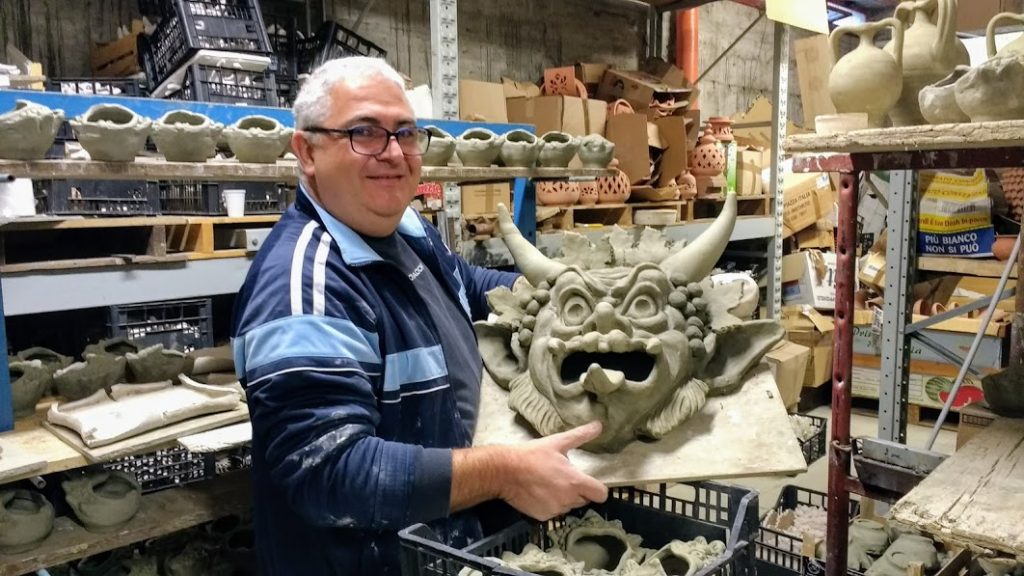
Enzo Ferraro in the drying room of his workshop with an apotropaic mask
FERRARO CERAMICS IN SEMINARA, CALABRIA
Amidst the many colors that both popped and melded, a mustard yellow prevailed in Enzo Ferraro’s shop. He told me that the area was rich with iron and that historically, the yellow color came from mixing local blacksmith scraps with clay.
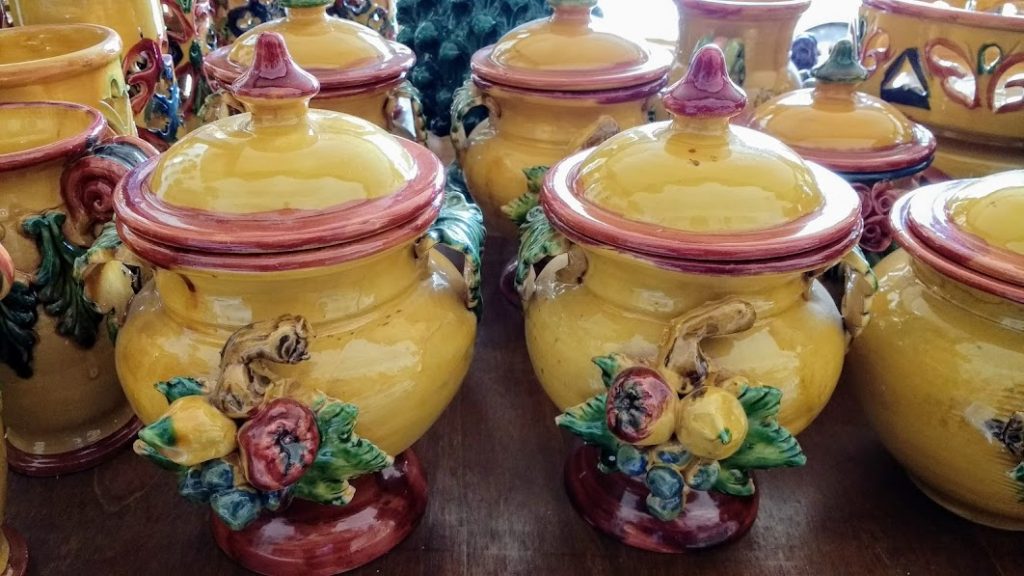
Ceramic containers of Enzo Ferraro in Seminara, Calabria
The ceramics ranged from traditional objects in unusual shapes to a myriad of miniature nativity scenes and refrigerator magnets. A couple of the unconventional forms caught my eye, such as a roundish object with little spike-like protrusions. The store had quite a display in varying colors and sizes. Enzo explained that these strange looking ceramic pieces were called ricci as the form resembles a sea urchin. Although the center of Seminara sits up on a hill at an altitude of 290 meters (950 feet), judging by the familiar name riccio (singular) that the form has acquired over the years, the town’s connection with the nearby Tyrrhenian Sea is clear. However, the round, pointy object actually represents the sun with its rays, and it was used to predict rainfall. The riccio was filled with water and if it evaporated, it meant that a drought was coming. But if after a certain period of time there was still water inside, the coming season would be humid with a good harvest.
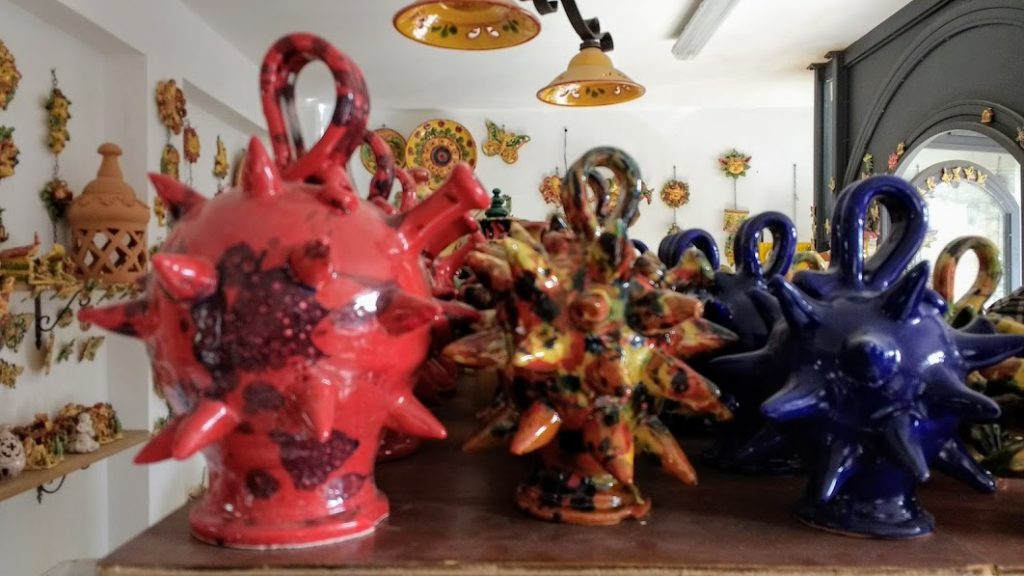
“Ricci” in the shop of Enzo Ferraro
Another interesting piece is the gabbacumpari in the local patois or bevi sei puoi in Italian, a vessel with which to make fun of someone, “drink if you can” in English. The drinking jug has a series of holes under the rim and if the drinker doesn’t cover the correct opening, the liquid spills out everywhere but the spout!
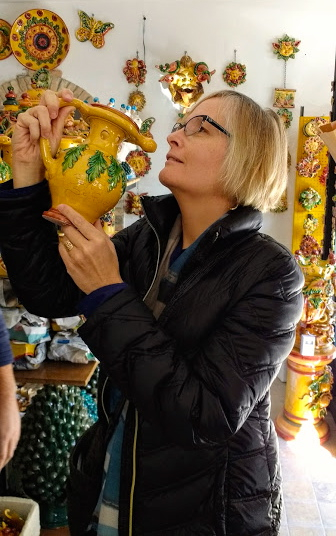
The author with a gabbacumpari in Enzo Ferraro’s shop in Seminara, Calabria
The fish, an ancient religious symbol, is another classic form in Seminara. Ceramic water bottles in the shape of a fish were sold to pilgrims on religious journeys over the centuries and are produced for tourists today.
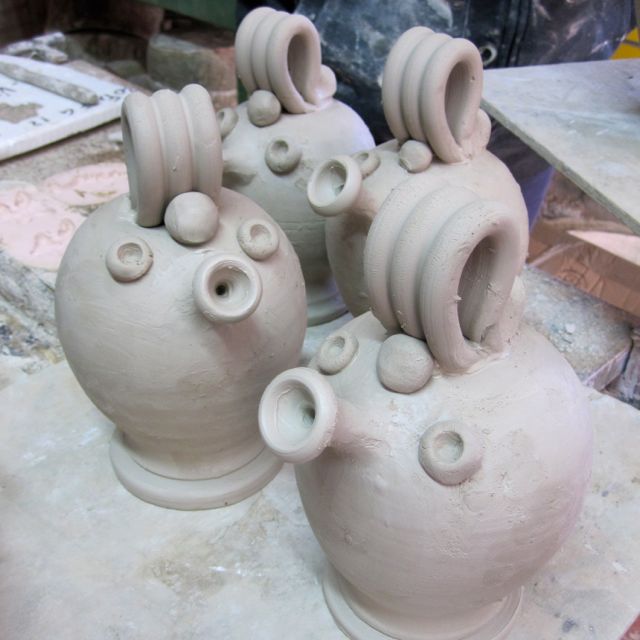
Clay containers in the form of stylized fish in the workshop of Enzo Ferraro
Enzo Ferraro also told me about the flaskokrùkella or ciambello, a ring-shaped container that is said to symbolize women. The convenient, donut-shaped drinking vessel could be easily carried out to the fields on a woman’s arm, slipped through the center. Legend has it that the wine contained in such a circular flask is dangerous for men and can lead to fuzzy thinking and even crime. Both the design of this ceramic piece and the associated popular tale are quite old, as there are records of a Greek bishop from nearby Bova who preached such warnings at the turn of the 12th century.
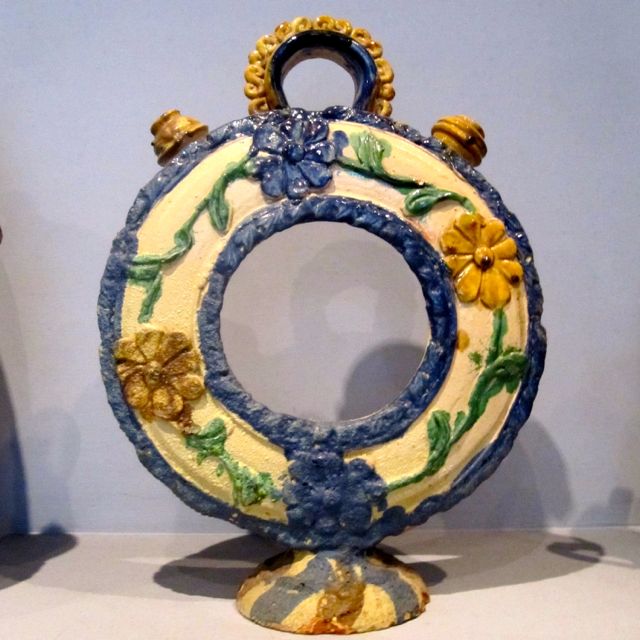
Flaskokrùkella from Seminara in the Casa della Cultura in Palmi, Calabria
SEMINARA, SUPERSTITION AND THE EVIL EYE
Another important category of Seminara ceramics features prominently in Enzo Ferraro’s workship, that of scaramanzia or the warding off of superstition. The evil eye of your neighbor cannot be left to linger unchecked, and what better than a fantastically designed ceramic piece to combat a malicious curse or even an unwanted glare?
The maschere apotropaiche or apotropaic masks are imbued with a power to avert evil influences or bad luck. Understandably, even the devil himself might think twice rather than mess with the threatening mugs in their distorted, multicolored glory, complete with dangling tongues and horns. These masks were placed on the doors of houses, over windows and on balconies, wherever evil could possibly get a foothold. The magical properties of the apotropaic masks were widely recognized, and even today, some masks are proudly displayed for folkloristic and artistic interests and others … the malignant beware!
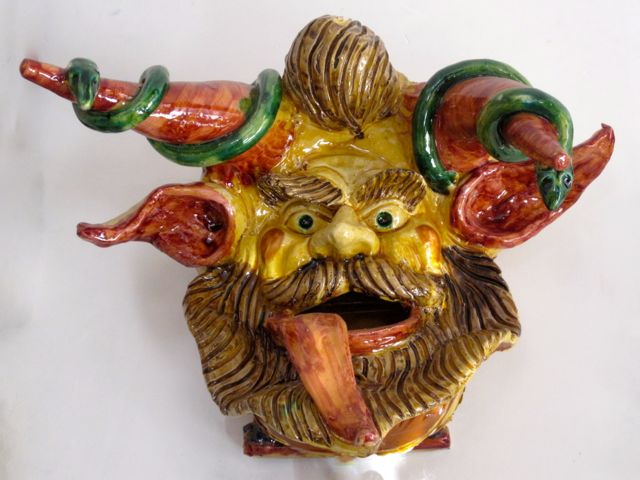
Maschera apotropaica or Apotropaic mask to ward off evil, Enzo Ferraro
The babbaluti are another evocative form of scaramanzia. Sculpted for maximum unattractiveness, the grotesque humanoids were positioned over chimneys to scare away evil spirits. Smoke blew out of their orifices.
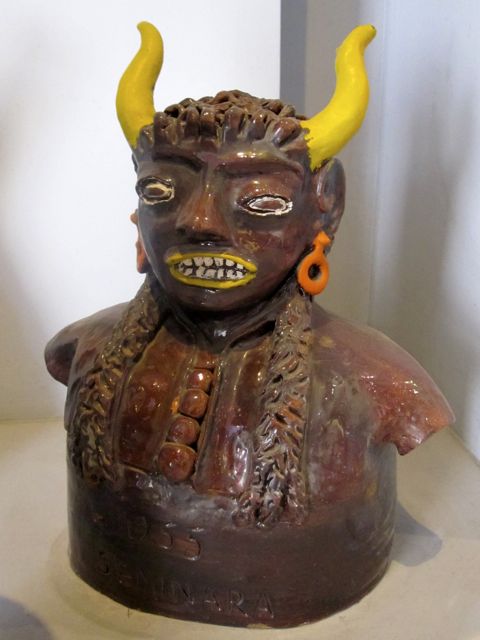
Babbaluto made in 1955 in Seminara, Casa della Cultura, Palmi
SEMINARA CERAMICS IN THE 21ST CENTURY
A little protection from the evil eye can’t hurt and the apotropaic masks to combat it are popular in Calabria. However, only a handful of ceramicists remain in Seminara to fashion these and other forms. The families Condurso, Ditto and Ferraro continue to practice the ancient craft, a few with a closer attachment to tradition and others following a road slightly less characteristic.
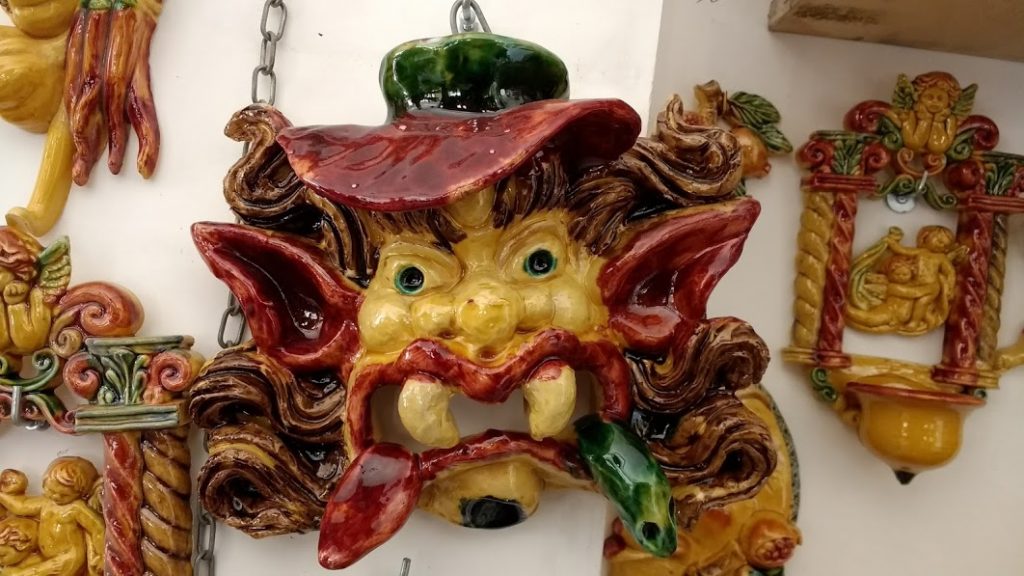
Apotropaic mask, Enzo Ferraro, Seminara ceramics
A good mix of the old and new, Enzo Ferraro also takes special orders. When I visited his shop, his assistant was busy working on a set of lovely porcelain vases with a contemporary design that were destined for a local florist.
Enzo Ferraro also has a project in the schools to capture the interest of younger students. Under his tutelage the children learn to work with clay in a program that lasts throughout the school year. They create saleable pieces and with the funds generated, the young people select a charity to which to donate the money. Recently, they bought a seeing eye dog for someone in need at the well-known school for the blind in Benevento, Province of Campania.
Surely, amongst family, programs for young children and apprenticeships, Seminara’s ancient tradition will carry forward, thanks to artisans like Enzo Ferraro and his colleagues in this southern Calabrian town. The characteristic ceramics, whose colorful exterior is only matched by its long history, proudly carry time-honored traditions forward and bear the Made in Italy label, by way of Calabria.
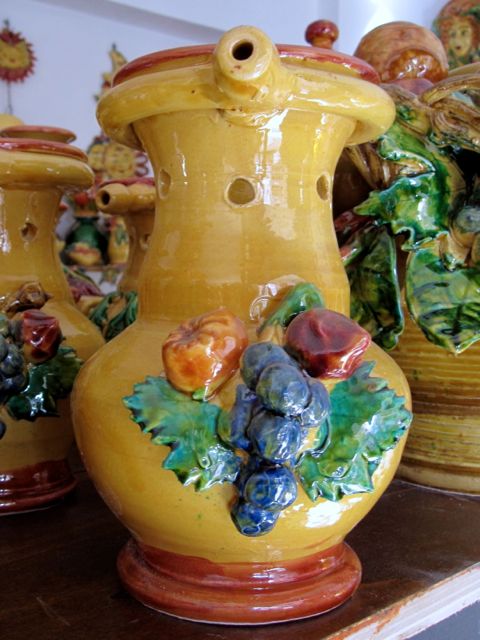
“Gabbacumpari” – Enzo Ferraro, Seminara
Ceramiche Artistiche Enzo Ferraro is located on Via Luzzatti, 1 in Seminara, Calabria. More about Seminara ceramics and nearby Palmi’s ethnographic museum with a beautiful folkloristic display in my blogpost Palmi, Calabria: The House of Culture.
 For an in-depth look at the beautiful land in the toe of the Italian boot, check out Calabria: The Other Italy, my non-fiction book about daily life, history, culture, art, food and society in this fascinating southern Italian region.
For an in-depth look at the beautiful land in the toe of the Italian boot, check out Calabria: The Other Italy, my non-fiction book about daily life, history, culture, art, food and society in this fascinating southern Italian region.
“Like” Calabria: The Other Italy’s Facebook page and follow me on Karen’s Instagram and Karen’s Twitter for more beautiful pictures and information.
Sign up below to receive the next blog post directly to your email.

Comments 16
I love the the fact that the artist is working in the schools & with the proceeds of the pieces sold, bought a seeing eye dog for someone in need. Fantastic!
Author
Absolutely, it’s so important to expose children to art at a young age and then for them to be able to share their positive experience through a donation to someone in need tops it off.
Thank you Karen for this very informative piece. I always wondered what those pieces with the spikes were! This is a wonderful Calabrian tradition that we can see from your article is being maintained.
Author
I’m glad you enjoyed it. I had also seen the spiky objects on a number of occasions and wondered what they were all about, so I was very happy to have the opportunity to learn about them from the source.
Hey Karen, That was a cute video of you and the young man in the store. You guys slipped from English to Italian without a hitch. I’m envious, barely knowing English. C
Charlie
Author
Ha, ha. Thanks – that was in Pizzimenti Specialty Calabrian Foods store in Reggio Calabria. It must have been on my Twitter newsfeed when you visited this page.
Hi Kar,
I, VERY MUCH, enjoyed this blog!! The art, imagination & whimsy, needed to produce these works, are incredible!!! And, the colors are all so vibrant! BELLISSIMO!!!
Liked the outfit you wore in the ‘town hall’ photo. A little nippy there, was it???
Ciao, & hope to see you soon, back in the States! 😄
Author
Thank you for your enthusiasm! It was actually a beautiful day – a little nippy early in the morning but then I took my jacket off and was inside/outside just with the scarf. Yes, I’ll be returning to the US next week. Ciao!
Hello Karen. My name is Amanda and this site is the first I have found with information on “Ferraro Italy” ceramics. I was given a Beautiful Garden fountain by my mother and wanted to get it insured however, I can not find any other information on his painted, lighted, Garden fountains. If possible could you please pass me any information regarding his fountains. If you respond by email I can send you pictures. Any help will be GREATLY appreciated. Thank you and have a Blessed day.
Author
Hi Amanda, The Ferraro family has been making ceramics in Seminara for 100 years. I will contact you by email for you to send me the pictures.
Wonderful art. I love them, beautiful and colorful. Thank You for this great post.
Author
I’m glad you enjoy these vibrant ceramics as much as I do!
Hello Karen, thank for your wonderful article! My fiancé brought me home two beautiful ceramic ladies. Both have a 6” base, and are 13” tall. Both with the name A.SEMINARA. One had a sticker that said HORCHOW made in Italy. (I got no information on the ladies on that site). With the name on the side, I found your beautiful story on the rich history behind these pieces of art. I would love to know more! Can I please send you pictures, so that hopefully you can tell me more about the ladies? Thank you for your time.
Author
My understanding is that Horchow started as a luxury mail-order catalogue that has since gone on-line and is now owned by Nieman Marcus. As you’ve read in the article, Seminara is a town in Calabria, South Italy known for its ceramics. I will send you a private message so you can send me the pictures and I will try to find out if your ladies originate in Seminara.
Great Article! Enzo is my cousin and I have so many of his wonderful pieces in my house. I stumbled on this article while looking for something on Seminara.
Author
It’s a small world! Lucky to have a house full of your cousin’s pieces. Glad you liked my post.